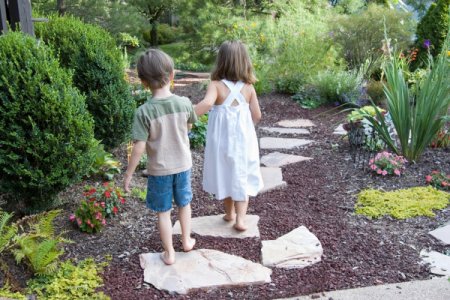Each month in our Open Voices blog we share insight from leaders in our communities who are advancing what it means to have sacred, open green spaces in our cities. As you resolve to make your 2015 a spectacular year, we encourage you to spend more time outside for you and your family’s mental health and well-being.
The mental and physical health of the children in your life is likely a top priority. When we talk about children and green spaces, we tend to think of planning and design for children as opportunities for running, jumping, swinging and climbing. Such gross motor activities are important to the physical health of children, but our mental health develops throughout childhood and life in subtler ways. Pause and think about when you were a child. Where did you play? How did you play? Do you remember picking up a small stick and discovering a world of tiny insects going about their day? Or spending an afternoon with your friends absorbed in a fantasy world built from imagination, found objects, and tall grass? Increasingly, child development researchers and playground designers are considering the interactions of natural objects and space, fine motor skills, and mental health. 1

The evidence for access to nature and child health is encouraging. Nature experiences can improve academic achievement, aid cognitive and intellectual development, foster physical activity, increase social health, reduce stress, enhance self-confidence, encourage imagination and creativity, and enhance ability to concentrate and exercise self-discipline.2 3 Research on childhood mental and physical development encourages planners and parents to consider play opportunities that support a diversity of sensory experience and aesthetic development; the development of competence and autonomy through freedom to explore and manipulate the environment; cooperation with others; and experience with other living things for their psychological and existential value.4
Consider several factors when planning and using green spaces in your community:
– Consider the very small scale involved in children’s environmental preferences and abilities. Children have a limited free range of movement. Small pockets of green space in a neighborhood allow for spontaneous experiences, a chance to explore safely, and a likelihood of chance encounters with neighborhood plants, animals and insects.
– Commonly the most valued spaces for children are those which have been forgotten by planners and other adults. Children place great value in being able to find and make places for themselves. The best landscape for children is often one which has been left to the power of nature (something landscape planners may want to dismiss). Some of these most valued landscape features are water, sand or dirt, trees, bushes, and tall grass, variable topography, animal life, things to build with, and “found” resources such as berries or fruits. Consider ways to design green spaces with a purposeful area for children to find and explore, even if it is among “weeds” disdained by adults.
– Take time to play and experience the subtle wonders in the trees and bushes right outside your door! Tell us about your experiences in the comment section below.
